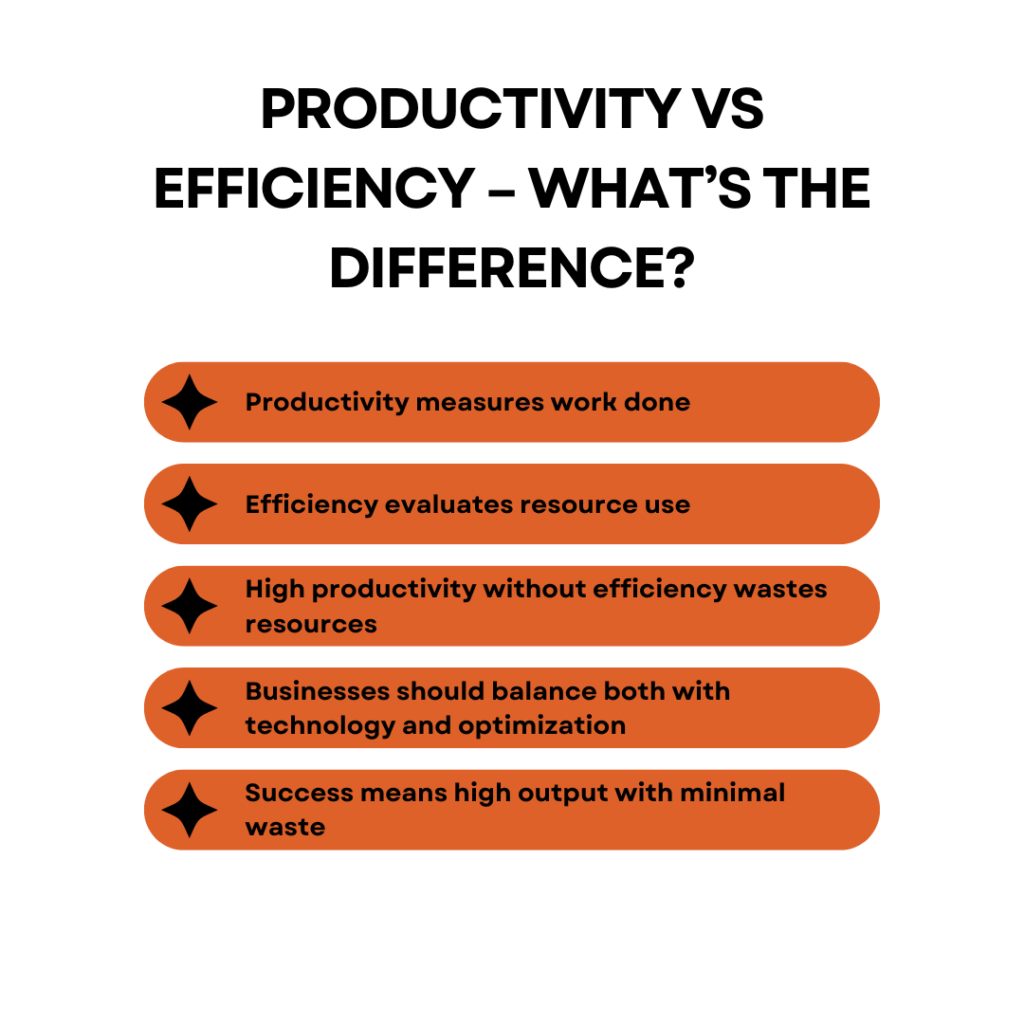
Productivity vs Efficiency – What’s the Difference?
Although productivity and efficiency are often used interchangeably, they represent distinct concepts. Productivity measures output, while efficiency evaluates the resources needed to achieve that output. Understanding the difference is crucial for individuals and businesses aiming to optimize performance without compromising quality.
Understanding Productivity
Defining Productivity

At its core, productivity is about volume. It quantifies how much work gets done within a given timeframe. Organizations typically measure productivity by tracking units produced, revenue generated, or tasks completed. Increased productivity often results in higher profits, better market positioning, and stronger overall performance.
Example 1: Manufacturing
A factory produces 1,000 units of a product per day. If it increases production to 1,200 units daily without adding workers or machines, productivity has improved. However, if quality suffers or defect rates increase, efficiency may decline.
Example 2: Sales Performance
A sales team that secures 50 deals in a month and later increases that number to 75, using the same resources, has boosted its productivity. If customer satisfaction drops due to rushed interactions, efficiency is compromised.
Read also : Why Stress Is Good
The Productivity Formula

A basic formula for measuring productivity is:
Productivity = Total Output / Total Input
For instance, if a company produces $100,000 worth of goods in a month using 2,000 labor hours, productivity is calculated as:
100,000 / 2,000 = 50
This means the company generates $50 per labor hour. However, without considering efficiency, this number alone does not indicate sustainability or effectiveness.
Factors Influencing Productivity

Several factors impact productivity, including technology, employee motivation, and process efficiency. Companies investing in better tools and streamlined workflows often see increased productivity. External factors such as economic conditions, market demand, and competition also influence output. Effective leadership, workplace culture, and goal alignment further contribute to productivity levels. Additionally, workforce skill levels, automation, and optimized workflows play a significant role in determining how much an organization can produce within a given timeframe.
Read also Mental Health Is Not a Joke
Understanding Efficiency
Defining Efficiency

Efficiency, on the other hand, is about optimization. It measures how effectively resources are utilized. Higher efficiency means achieving the same results with fewer inputs, reducing costs and minimizing waste.
Example 1: Writing & Editing
A content writer produces 10,000 words per week, but half require extensive editing. Another writer produces 8,000 words with minimal revisions. The second writer is more efficient, as their work requires less rework and time investment.
Example 2: Software Development
A developer who writes 1,000 lines of clean, functional code is more efficient than one writing 1,500 lines full of redundancies, as the former’s work requires less debugging and maintenance.
Read also : The Difference Between Habit and Addiction
The Efficiency Formula

Efficiency is calculated as:
Efficiency = (Standard Input / Actual Input) x 100
If a process should take 100 hours but actually takes 120, efficiency is:
(100 / 120)×100 = 83.3%
Read also : How to Be More Confident: 10 Tips That Work
Factors Influencing Efficiency

Efficiency is influenced by workflow organization, employee expertise, and the quality of tools used. Companies that optimize work processes, reduce redundancies, and provide adequate training enhance their overall efficiency. Proper time management and decision-making also play significant roles. Workplace ergonomics, automation, and continuous improvement methodologies further contribute to efficiency. Organizations that emphasize lean management and eliminate unnecessary steps in a process often see better efficiency outcomes.
Read also : How to Overcome Challenges to Goal Achievement
Productivity vs Efficiency: Key Differences

1. Quantity vs Quality
Productivity focuses on output, while efficiency considers resource allocation. A restaurant serving 300 meals per night is productive, but if half of those meals are returned due to poor quality, efficiency suffers. The ability to balance both is crucial for sustained success.
2. Short-Term Gains vs Long-Term Sustainability
Maximizing productivity without considering efficiency can lead to burnout, rework, and waste. Sustainable growth requires balancing both. Employees working longer hours may complete more tasks in the short term, but excessive work reduces efficiency over time due to fatigue and errors.
3. Measuring Impact
A business increasing output by 20% might seem successful, but if expenses rise by 30%, efficiency declines. Evaluating both metrics ensures profitability. Businesses that emphasize both measures experience steady growth without sacrificing quality. Strategic planning ensures optimal results in both areas.
4. Resource Allocation
A team may complete more projects by increasing productivity, but if they use excessive resources, their efficiency suffers. An efficient team prioritizes essential tasks, eliminating unnecessary steps and reducing wasted efforts. Smart delegation and automation further enhance efficiency.
5. Innovation and Adaptability
Efficiency encourages businesses to refine processes, leading to innovation. A highly efficient company continuously assesses performance, integrates new strategies, and minimizes wasted effort while maintaining high output. Companies that fail to balance efficiency and productivity risk stagnation and decline.
Read also : How to Increase Productivity at Work
Finding the Right Balance

Achieving both productivity and efficiency is essential for long-term success. Here’s how organizations can strike a balance:
1. Leverage Technology
Automation tools reduce manual work while maintaining accuracy. For instance, AI-powered chatbots handle customer inquiries efficiently, allowing human agents to focus on complex issues. Project management software like Trello or Asana helps teams stay organized, improving both productivity and efficiency. Businesses utilizing advanced analytics and AI-driven insights enhance decision-making processes. Additionally, data visualization tools provide insights into inefficiencies, enabling better process optimization.
2. Prioritize Process Optimization
Lean methodologies eliminate waste, improving efficiency without sacrificing output. Manufacturing companies using Six Sigma reduce defects while maintaining high productivity. Businesses that streamline communication reduce unnecessary meetings and optimize decision-making. Implementing clear protocols ensures smoother operations and minimizes bottlenecks. Continuous process evaluations help identify inefficiencies before they become major roadblocks.
3. Employee Training & Well-being
Overworking employees may boost short-term productivity but leads to burnout and decreased efficiency. Encouraging work-life balance and continuous learning enhances long-term performance. Companies investing in upskilling programs equip employees with tools to work smarter, not harder. Well-structured incentive programs further encourage both efficiency and productivity. Organizations that focus on employee well-being see increased engagement, which directly impacts efficiency.
4. Data-Driven Decision Making
Analyzing performance metrics allows businesses to adjust strategies in real time. Tracking both productivity and efficiency provides a clearer picture of areas needing improvement. Companies that use data insights make informed choices, reducing waste and maximizing output. Predictive analytics and trend forecasting enhance strategic planning. Businesses that utilize benchmarking practices ensure continuous growth in both productivity and efficiency.
5. Encouraging a Culture of Efficiency
Leaders should foster an environment where efficiency is valued alongside productivity. Rewarding employees who find smarter ways to work encourages innovation and helps sustain long-term success. Open communication, transparent goal-setting, and recognition of accomplishments further reinforce this culture. A well-defined workplace structure ensures that efficiency remains a core focus without compromising output.
Read also : How to Discipline Your Mind
Conclusion
Productivity and efficiency must work together for sustainable success. High output without optimization leads to wasted resources, while excessive focus on efficiency may slow progress. Businesses and individuals should aim for a balance where work gets done effectively without unnecessary effort, ensuring long-term growth and stability. By leveraging technology, refining processes, and supporting employee well-being, organizations can create a productive and efficient work culture that thrives in any industry. Strategic alignment, continuous learning, and proactive adaptability ultimately drive success in an evolving marketplace. A thoughtful approach to both productivity and efficiency creates resilient organizations capable of sustaining excellence over time.
If you want to go further, here’s a guide. To get it, click here!




